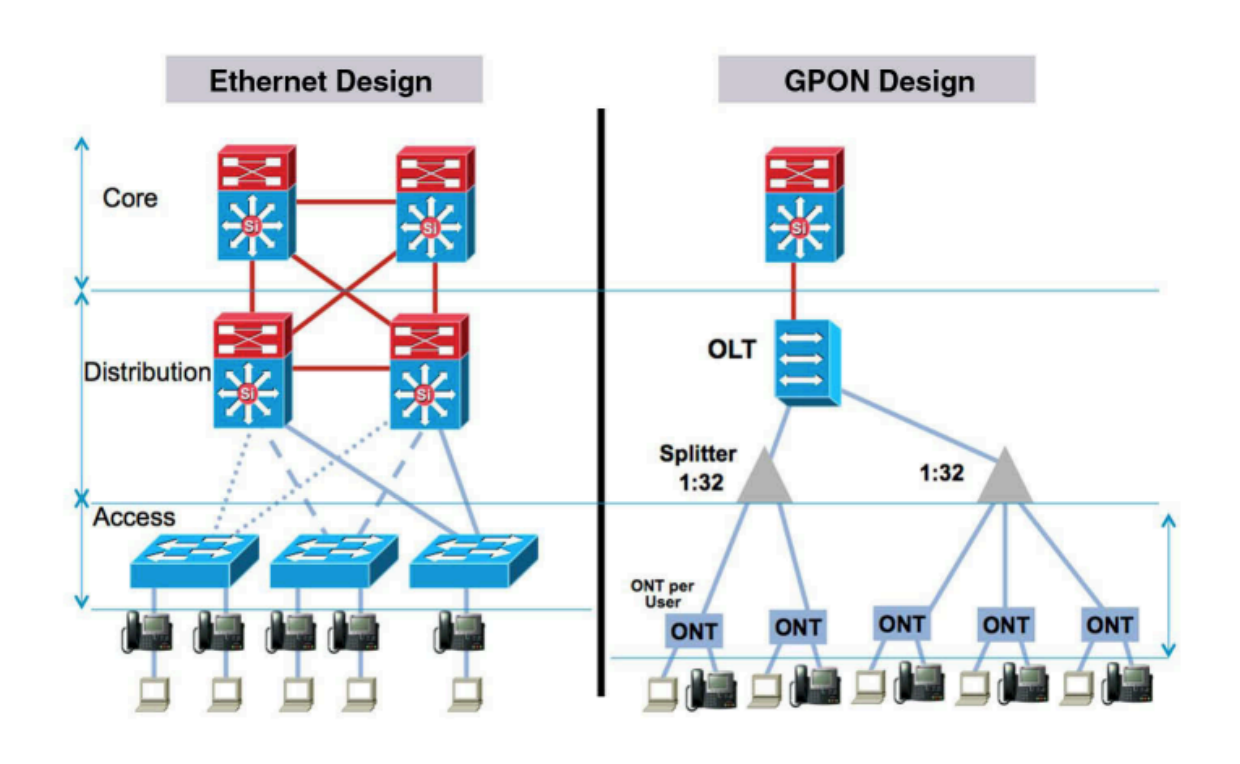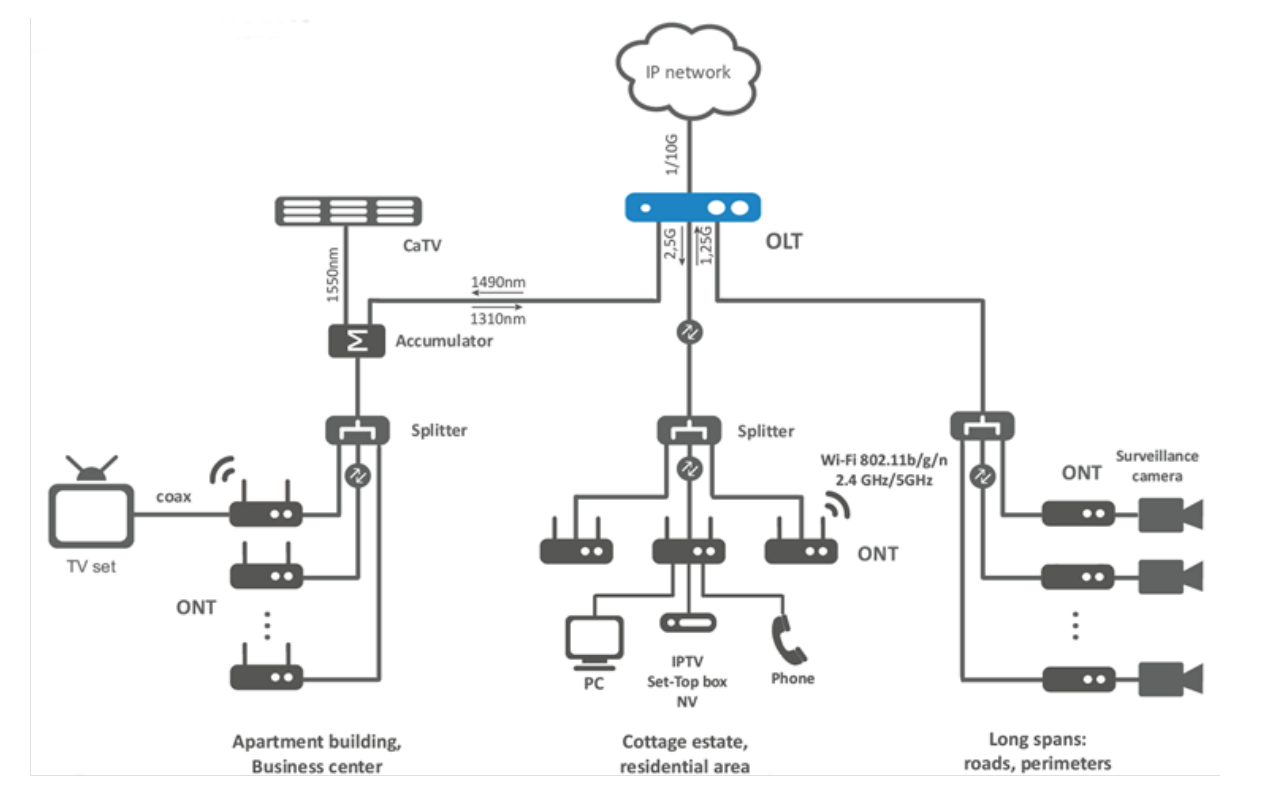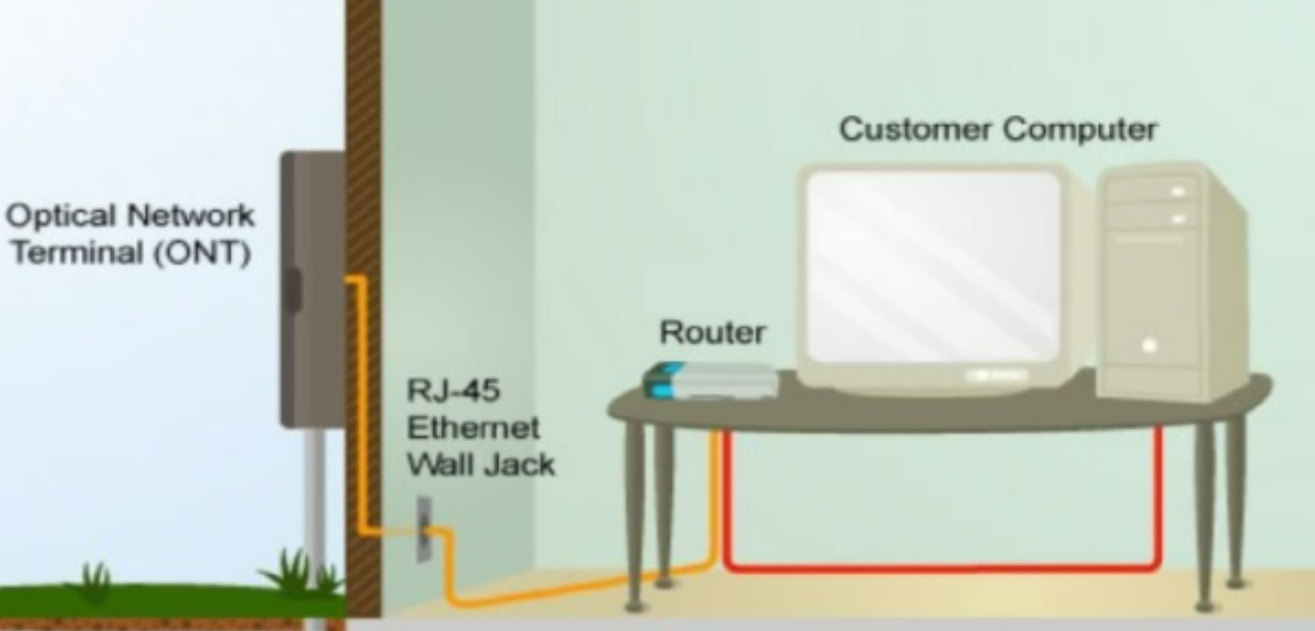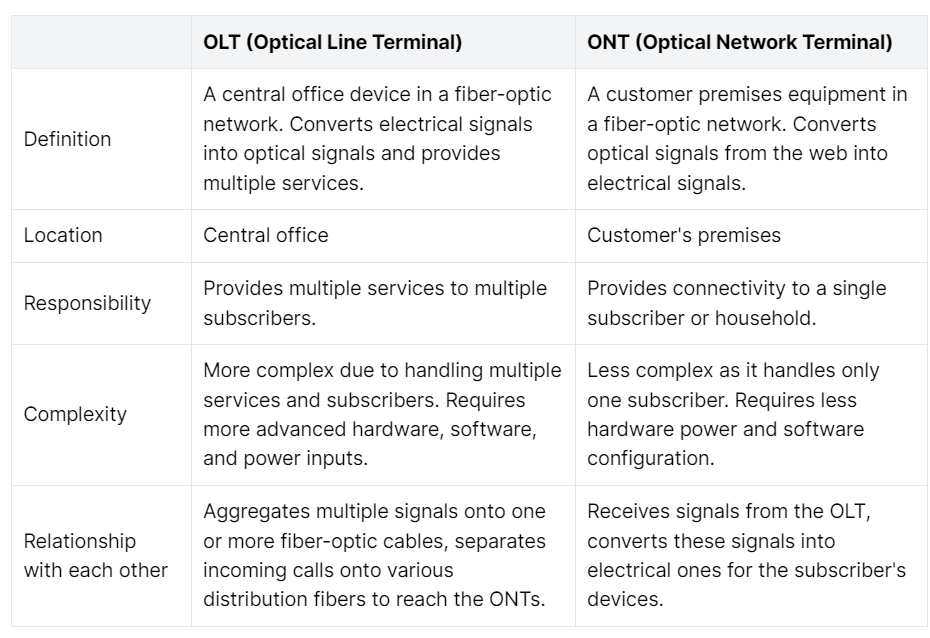Gigabit Passive Optical Network (GPON) is a communications technology for Fiber-to-the-Home (FTTH) broadband installations. The GPON architecture features two critical devices: the Optical Line Terminal (OLT) and the Optical Network Terminal (ONT). These two components are responsible for establishing reliable communication between service provider networks and customer endpoints, becoming even more integral as consumer internet bandwidth demands skyrocket and become ever more complex. This blog post’ll look at how these essential components work together to form robust access networks over optical fiber infrastructure. You’ll better understand their roles within GPON deployments and tips for ensuring successful installation and performance.

In its simplest form, GPON stands for Gigabit Passive Optical Network. It is a fiber optic communication technology that enables data transmission over long distances in a manner that is both efficient and cost-effective. GPON is a preferred technology for fiber optic networks because it can support a range of network architectures, ranging from small home networks to large-scale enterprise networks.

GPON works by utilizing single-mode fiber-optic cables that transmit data through light signals. The main components of a GPON system include the Optical Line Termination (OLT), Optical Network Unit (ONU), and Passive Optical Splitter. The OLT is responsible for transmitting data downstream, while the ONU transmits data upstream. The Passive Optical Splitter is responsible for splitting the optical signal into multiple signals that can be distributed to end-users.
When data is transmitted, it is first compressed and packaged into small packets before being shipped to the OLT. The OLT then uses multiple wavelengths to transmit the data to the Passive Optical Splitter. Once the signal reaches the Passive Optical Splitter, it is split into various cues sent to the ONUs attached to the Splitter. Finally, the data is transferred from the ONUs to the end-users.
The benefits of GPON technology are numerous and diverse. One of the primary benefits of GPON technology is its high bandwidth. GPON technology can support up to 2.5 Gbps downstream and up to 1.25 Gbps upstream. This high bandwidth makes it possible to transmit large amounts of data over long distances quickly.
Another benefit of GPON technology is its scalability. It is possible to add new users to a GPON network without installing new fiber optic cables. This is because GPON technology uses a point-to-multipoint architecture, meaning multiple ONUs can be connected to a single OLT.
Finally, GPON technology is cost-effective. Implementing GPON technology at a lower cost than traditional copper wire technologies is possible. This allows service providers to offer high-speed internet, IPTV, and other digital services at a lower price.
GPON technology has been successfully deployed in many parts of the world. Some of the most notable examples include Japan, where GPON has been used to provide high-speed broadband services to residential and business customers. In India, GPON has been used to deliver digital services to remote villages where traditional copper wire technologies are either unavailable or unreliable. In Europe, GPON has been deployed to provide high-speed internet and digital services to public institutions such as libraries, schools, and hospitals.

As the backbone of a Gigabit Passive Optical Network (GPON), an Optical Line Terminal (OLT) is the central interface between the service provider and customers. OLT is an optical network equipment that aggregates and distributes data through multiple Optical Network Units (ONUs) at the customer’s premises. It is an essential device in modern telecommunications infrastructure, allowing service providers to offer their customers high-speed internet, TV, and voice services.
An OLT is a high-capacity device that serves as the transmission endpoint in a GPON network. It is responsible for converting electronic data into optic signals transmitted over fiber-optic cables to the customer’s premises. The OLT aggregates traffic from multiple ONUs and ensures efficient data transmission throughout the network. It provides several essential functions, including packet-switching, traffic scheduling, and Quality of Service (QoS) management.
The OLT consists of several components, including a Central Processing Unit (CPU), a Register Memory (RM), an Upstream Transceiver (Tx)/Downstream Receiver (Rx), and a Power Unit (PU). The CPU manages and controls the overall OLT operation, while the RM stores the OLT configuration file. The Tx and Rx units transmit and receive data over the network, and the PU provides power to the device.
In a GPON network, an OLT sends and receives data through an Optical Distribution Network (ODN). The ODN is a passive network consisting of fiber-optic cables, splitters, and couplers connecting ONUs to the OLT. The OLT transmits data downstream and upstream through the ODN using a specific protocol, such as the Gigabit-capable Passive Optical Network (G-PON) protocol. The downstream data is sent from the OLT to the ONUs, while upstream data is sent from the ONUs to the OLT. The OLT uses an Optical Time-Division Multiple Access (OTDMA) protocol to manage the upstream data transmission, ensuring data is transmitted without collisions.
In conclusion, the Optical Line Terminal (OLT) plays a crucial role in operating a Gigabit Passive Optical Network (GPON). It manages and controls the data transmission between the service provider and the customers. The OLT comprises several significant components, including a CPU, RM, Tx/Rx, and PU, which work together to ensure a reliable and efficient connection. By understanding the essential functions of OLT in a GPON network, service providers can offer high-speed and reliable services to their customers.

The Optical Network Terminal (ONT) is an essential Fibre-to-the-Home (FTTH) network component. It connects the last-mile optical fiber to the end-user device, which could be a computer, router, or telephone. It enables the distribution of multiple services through a single optical fiber, including high-speed internet, voice, and video. Its primary function is to convert the optical signals transmitted over the fiber optic cable into electrical signals that the end-user device can understand.
The ONT comprises several critical components that work together to ensure seamless and reliable data transmission. The first essential component is the optical line terminal (OLT), which aggregate traffic from multiple ONTs. It is responsible for routing and forwarding data packets between the ONTs and the core network. The second component is the power supply, which provides power to the ONT. The third component is the fiber optic transceiver, which receives and transmits signals over the fiber optic cable. The fourth component is the Ethernet switch, which enables communication between the ONT and the end-user device. Finally, the management interface provides access to the ONT configuration settings and status information.
In a Gigabit Passive Optical Network (GPON), the ONT plays a significant role in transmitting data from the Optical Line Terminal (OLT) to the end-user device. The ONT receives downstream signals from the OLT that are transmitted over the fiber optic cable. It then converts these optical signals into electrical signals that the end-user device can understand. The ONT then transmits upstream signals to the OLT via the fiber optic cable, allowing for two-way communication. The ONT also performs various functions such as data encryption, Quality of Service (QoS) management, and network management.

Optical Line Terminal (OLT) is a central office device serving as a fiber-optic network communication hub. It is primarily responsible for converting electrical signals into optical signals and transmitting them over optical fibers. Additionally, OLT provides a wide range of services, including internet, voice, and video services, to subscribers connected to the network.
Optical Network Terminal (ONT) is a customer premises equipment (CPE) that is an endpoint device in a fiber-optic network. ONT is responsible for converting optical signals from the web into electrical signals for a subscriber’s device use. ONT also provides various local network connectivity options, including Ethernet and Wi-Fi, to the instruments of the subscribers.
The primary difference between OLT and ONT is their location in the network infrastructure. OLT is a central office device, while ONT is deployed at the customer’s premises. OLT is responsible for providing multiple services to multiple subscribers, while the ONT is responsible for providing connectivity to a single subscriber or a single household.
OLT is more powerful and complex than ONT since it handles multiple services and subscribers. OLT requires more advanced hardware, software, and configuration, including more substantial power inputs, to support various services. On the other hand, ONT is more straightforward since it only needs to keep one subscriber, thus requiring lesser hardware power and software configuration.
OLT and ONT work hand in hand to provide communication services to subscribers in a fiber-optic network. An OLT aggregates multiple signals onto one or more fiber-optic cables while simultaneously separating the incoming calls onto various distribution fibers to reach the ONTs of subscribed customers. ONTs at the customer’s premise then convert these signals into electrical ones for the subscriber’s devices.
In conclusion, the Optical Line Terminal (OLT) and Optical Network Terminal (ONT) are essential components of fiber-optic network infrastructure. They play different roles in the network, with OLT as the central office device that aggregates signals from multiple subscribers. In contrast, ONT serves as the customer premises equipment that provides connectivity to a single subscriber or household. Understanding OLT and ONT’s unique features, functionality, and use cases is crucial in selecting and deploying them appropriately based on specific needs and project requirements.
The OLT serves as the central hub of the GPON network. It connects to the internet service provider’s (ISP) backbone, and its primary function is to distribute high-speed broadband services to different ONTs. The OLT unit consists of several physical ports, each with other functionalities. Some essential ports on an OLT include the Network Interface Port (NIP), PON Port, Management Port, and Console Port.
The Network Interface Port on the OLT is where the ISP’s primary internet connection is plugged in. This port has WAN (Wide Area Network) capabilities and is the primary internet gateway for the entire GPON network. The PON port is connected to the ONT, which is responsible for transmitting and receiving data between the OLT and the subscriber’s ONT. The Management Port allows network administrators to configure the OLT unit using a web-based interface or Simple Network Management Protocol (SNMP). Lastly, the Console Port is a direct interface for technicians to access the OLT’s command line interface for manual configurations and troubleshooting.
The ONT is the end-user device that receives high-speed broadband services from the OLT. It connects to the PON port on the OLT through a single fiber-optic cable. The ONT unit comes in different models, each with different port types and functionalities. Some common types of ports found on most ONTs include Ethernet port, Voice port, Wi-Fi port, and POTS (Plain Old Telephone Service) port.
The Ethernet port on the ONT provides subscribers internet access over a wired connection. The Voice port allows for voice communication over an internet protocol (IP) network, while the Wi-Fi port enables subscribers to access the internet wirelessly. The POTS port enables subscribers to connect to the traditional telephone landline. ONTs with multiple Ethernet or Wi-Fi ports can offer subscribers multiple wired and wireless connectivity options, including switching between them for better connectivity and convenience.
Installing an OLT requires careful planning and preparation to ensure that the device is appropriately placed, connected, and configured. The first step is to select a suitable location free from environmental hazards and with a steady power supply. Once the correct place has been identified, the OLT is mounted, and the power and network cables are connected. The next step involves configuring the device and setting up the ports, VLAN, IP addresses, and other network parameters. The configuration process also includes setting up security features, such as firewalls, to prevent unauthorized access to the network.
The installation and configuration of ONT involve connecting the user’s devices to the network. This process is relatively straightforward and consists in connecting the user’s device to the ONT, which bridges the device and the web. The ONT is usually placed within the user’s premises, and the connection is made through an Ethernet or Wi-Fi. Once the device is connected, it is configured to access the internet or other networks. The configuration process involves setting up the network parameters, such as IP addresses, VLAN, and quality of service. Additional security features may also be configured to protect the user’s devices and data.
GPON OLT and ONT deployment has revolutionized network infrastructure by enhancing its speed, performance, and efficiency. GPON technology provides high-speed data transmission over optical fibers, delivering high-quality multimedia content, such as video streaming, online gaming, and virtual reality. GPON also allows for greater bandwidth allocation, which means more users can connect to the network without affecting the quality of service. Additionally, GPON is much more energy-efficient than traditional network infrastructures, reducing operational costs and improving sustainability. In summary, deploying GPON OLT and ONT is an essential requirement for modern network infrastructures, enabling the delivery of high-speed data transmission, improved performance, and increased efficiency.
GPON, OLT, and ONT are essential elements in modern Broadband Networks. GPON, which stands for Gigabit Passive Optical Network, is a sophisticated optical technology that provides high-speed internet and multimedia services. It is a powerful communication system capable of transmitting high volumes of data at extremely high speeds, making it ideal for modern communication networks.
OLT, the Optical Line Terminal, is the interface between the internet provider’s network and the user’s premises. The OLT is responsible for managing and controlling data transfer to the entire network, including all the ONTs. It acts as the gateway that connects all traffic from various subscribers to the internet. Without OLT, the transfer of data packets between different ONTs becomes impossible.
ONT, the Optical Network Terminal, is the hardware at the user end that receives and decodes signals from the OLT. ONTs are devices that bridge the gap between the internet service provider and the end-users of the network. These devices are connected to various end-user devices, such as computers, laptops, mobile devices, and TV set-top boxes. ONTs are also responsible for converting the optical signals transmitted by the OLT into electrical signals suitable for end-user devices.
Together, these three elements form a robust system capable of providing high-speed broadband connectivity to multiple users over long distances. The OLT and ONT communicate with each other through fiber optic cables, enabling data transmission at gigabit speeds in both directions. They also significantly increase the number of devices and users that can connect to the network, making it more versatile and efficient.
The use of GPON technology provides several advantages over traditional broadband solutions. First, it offers faster data rates, essential for modern communication requirements. Second, GPON is a more cost-effective since it requires less hardware and fewer cables. Third, it is a more reliable system with fewer connectivity issues, which is essential for business-critical applications. However, GPON networks are also subject to limitations, including distance constraints, compatibility issues with existing infrastructure, and sensitivity to power outages.
In the real world, GPON, OLT, and ONT are currently utilized in numerous broadband networks, such as homes, offices, and campuses. For example, GPON technology is widely used in universities and schools. It offers high-speed internet connectivity to students and staff, making sharing large multimedia files easy and fast. Similarly, GPON technology is utilized by telecommunication companies, enabling them to offer internet access and voice services to their customers. Thus, GPON, OLT, and ONT have continued to revolutionize the world of broadband networks, making internet access faster, more reliable, and more accessible worldwide.

The need for high-speed and reliable internet connections has become critical as the world becomes increasingly interconnected. GPON technology, also known as Gigabit Passive Optical Networks, is a fiber-optic communication system that has gained widespread adoption for its ability to provide high-bandwidth connectivity over long distances. This article will explore current and future developments in GPON technology that will transform the telecommunications industry.
GPON technology is based on industry standards set by the International Telecommunications Union (ITU). The GPON standard supports a downstream data rate of up to 2.5 Gbps and an upstream data rate of up to 1.25 Gbps. However, advancements in GPON standards have allowed for faster networks, more robust security measures, and greater bandwidth utilization.
The ITU has developed enhancements to the GPON standard, including XGPON and NG-PON2. XGPON allows for a downstream data rate of up to 10 Gbps and an upstream data rate of up to 2.5 Gbps. NG-PON2 has a downstream data rate of up to 40 Gbps and an upstream data rate of up to 10 Gbps. The increased speeds enable wider usage, more applications, and optimizing network performance.
GPON technology has several major potential applications in telecommunications. One of the most important is delivering high-speed broadband services to households and businesses. GPON technology can deliver the speed of 10 Gbps, enabling ultra-high definition video streaming, online gaming, and other bandwidth-intensive applications.
GPON technology can also be used in the healthcare industry, enabling remote diagnosis, telemedicine, and virtual consultations. Remote surgeries are one potential application that can provide more medical services to more patients globally. The technology can also be used in the energy industry for intelligent metering and monitoring, enabling real-time usage tracking and reducing operational costs.
One of the most promising emerging technologies that utilize GPON technology is 5G. 5G networks can provide ultra-high-speed internet access to mobile devices, enhancing the quality and reliability of mobile networks in densely populated areas. 5G also promises to provide low latency, enabling applications in industries such as self-driving cars, augmented/virtual reality, and intelligent cities.
Another emerging technology that utilizes GPON technology is the Internet of Things (IoT). IoT enables remote connectivity between everyday devices and networks. GPON can provide high-speed internet to these devices, enabling seamless communication between them. IoT devices can be used in homes, offices, and industrial settings, enabling greater efficiency and control over environmental, safety, and security parameters.
In the future, the trend is towards providing faster and more reliable internet, and GPON technology is primed to play a significant role in achieving this goal. The future developments in GPON technology focus on providing even faster networks, more robust security measures, and greater bandwidth utilization.
One of the Improvements is in integrating GPON with DOCSIS. DOCSIS 4.0 can supply 10 Gbps symmetrical speeds by combining the DOCSIS 3.1 across a fiber-to-the-home (FTTH) connection. This technology enables 10 Gbps for the downstream and upstream flow. Another development in GPON technology is the use of WDM-PON technology, which can provide up to 100Gbps of data over a single fiber.
The future for GPON technology is bright, with continuous advancements set to transform the industry. The technology’s growing adoption ensures we will have faster and more reliable internet connections, enabling us to lead a connected and efficient lifestyle that many dreamed of just a few years back.
A: GPON stands for Gigabit Passive Optical Network, a type of optical fiber network technology that uses a single fiber to provide multiple services such as data, voice, and video to end users.
A: OLT stands for Optical Line Terminal. The central equipment in a GPON network is responsible for managing and controlling the overall network. OLT connects to the ODN (Optical Distribution Network) and distributes different data types and voice traffic from users to the appropriate destinations.
A: ONT stands for Optical Network Terminal. It is a device located at the customer’s premises that connects to the OLT via the ODN. ONT modules on the ODN receive and transmit data and voice signals between the end-user devices and the GPON network.
A: The main functions of an OLT in a GPON network are:
A: The main functions of an ONT in a GPON network are:
A: GPON and EPON are both types of PON (Passive Optical Network) technologies, but they differ in the underlying standards they follow. GPON adheres to the ITU-T G.984 standard, while EPON follows the IEEE 802.3ah standard. GPON is known for its higher bandwidth and more extended reach, while EPON is more cost-effective and more straightforward in its architecture.
A: Dynamic bandwidth allocation in GPON is a mechanism that allows the OLT to allocate available bandwidth to ONTs based on their current needs. This ensures efficient utilization of network resources by dynamically adjusting the allocated bandwidth among different ONTs according to their traffic demands.
A: The GPON standard is the ITU-T G.984 standard, which defines the specifications for a passive optical network using gigabit-capable PON technology. It outlines the protocols and interfaces required to transmit data, voice, and video over a GPON network.
A: GPON plays a crucial role in fiber optic networks by providing a cost-effective and efficient solution for delivering high-speed broadband services to end users. It enables the transmission of large amounts of data and supports various services such as internet access, VoIP, and video streaming. GPON also allows for flexible network scalability and future-proofing.
A: Some advantages of GPON over traditional copper networks are: